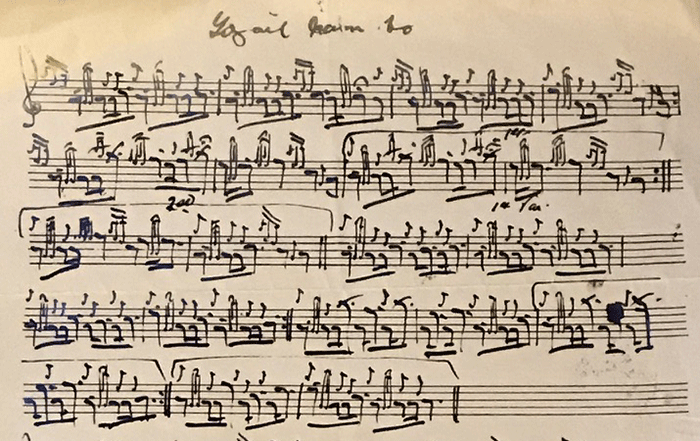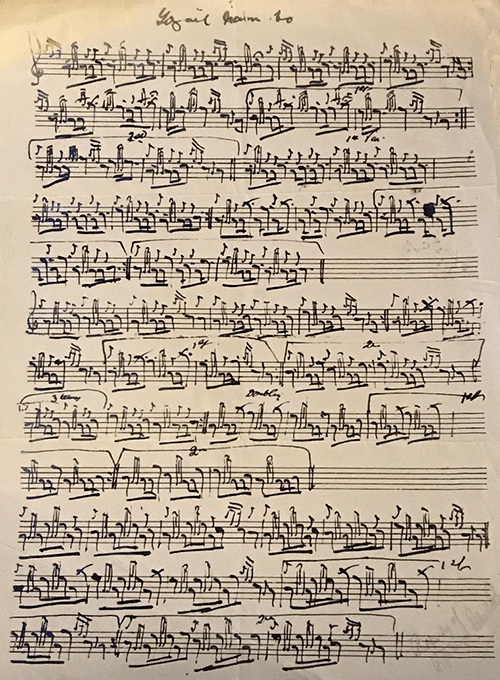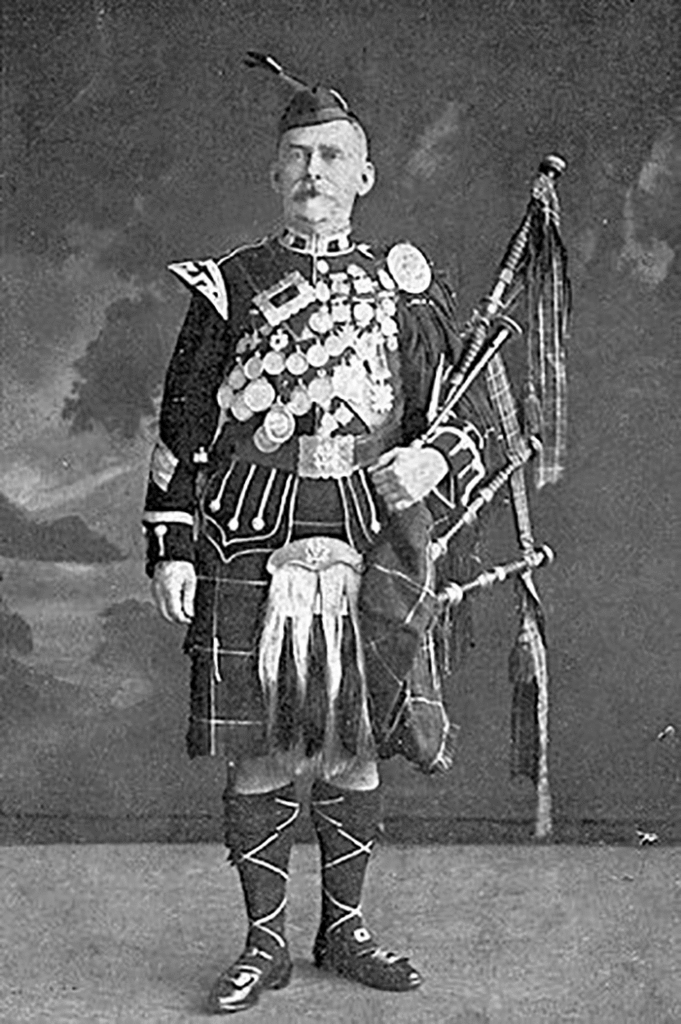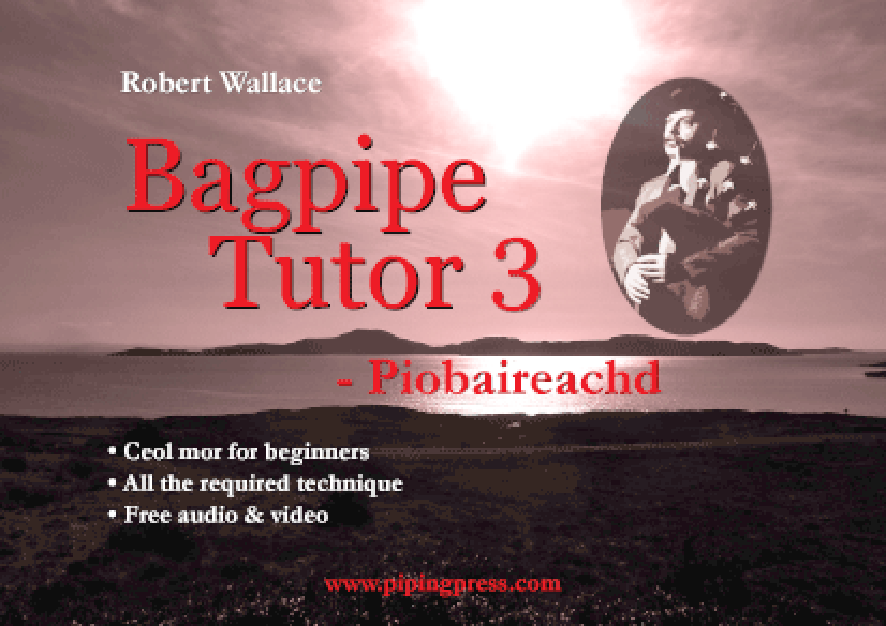
The music here is by the hand of the legendary John MacDougall Gillies and belonged to his pupil Robert Reid. Check out the full score below where you can just make out Reid’s signature bottom right ‘Property of Pipe Major Robert Reid’.
All piobaireachd players will recognise the tune as MacFarlane’s Gathering or, as is given here, ‘Togail nam Bo’ (Taking of the Cattle’), rustling to Western fans. I read online that there is a pibroch song for the Clan MacFarlane of the same name. More:

‘This piobaireachd reflects the free spirit of this ancient, enterprising clan. Originating in the Loch Sloy and Inverglus area near the head of Loch Lomond, the clan in its time enjoyed a well-deserved reputation, along with their sometime partners, the MacGregors, as cattle reivers without peer. By the end of the 16th century they were a broken clan, proscribed and deprived of lands and name.
‘The composer of the piobaireachd is reputed to be Andrew MacFarlane, Chief of the Clan in the early 1500s. If so, this makes the tune one of the older piobaireachd in the hierarchy. The term ‘Macfarlane’s Moon’ arises from their practise of carrying out their cattle raids in the darkest of nights; in other words, no moon at all.’
The piobaireachd manuscript was reputedly discovered by MacDougall Gillies in a farmhouse in his native Glendaruel, not too far from Loch Sloy, and, despite its similarity to Too Long in this Condition, it has become a favourite in its own right.
Here is the full score:

And readers who want to download a PDF can do so here:
Let us look more closely at JMG’s score. As it pre-dates the Piobaireachd Society collection no influence from that quarter can be ascribed to it. So proof again that the opening cadence E structure (the long introductory E as a semi-quaver gracenote) was in accepted use by pipers who could read and write music well before Book 1 in the PS series took the piping world by storm in 1926. It should be no surprise that the Society, wishing to conform to the norm, used this motif in its celebrated collection – even though a literal reading makes a nonsense of traditional teaching.
Moving on to the first taorluath we see that it is written with the ‘redundant’ A as taught by Gillies, by his pupil Reid and by his pupil RG Hardie. Again, however, we do not want the movement to sound as it looks. We may practice it as written but it must be played without rhythmic interruption, a preserve of only the most skilled. If it comes off we add depth to the movement (an extra gracenote actually).
We do it in the crunluath too; look further down the score. Again, this is how JMG and his acolytes taught and played it. Reid’s crunluath is still something of legend in Glasgow and I can attest that Hardie’s was strong right up until the time a hand injury ended his playing days.
One other advantage of writing the ‘redundant’ A in the taorluath is that it enables us to write the ground in a sort of pseudo 4/4 time and the taorluath variation in 6/8. A few dots would need to be added to this score to achieve arithmetical exactitude but it is possible to get things squared away without too much effort.
Why the need? Mainstream music practice was the guide for the 19th century writers taking an oral tradition and putting it on the stave. Following on, the learned, early 20th century editors, engineers and lawyers, wanted to kept it that way. It confirmed their training. All equations must satisfy; law must order life and piping life – even where this, prima facie, flew in the face of traditional teaching. The score had to be put into regular packets of mathematically modulated melody.

Had they had a more enlightened outlook, or perhaps one less concerned with the principles of standard music writing practice, easier for us today, they may not have used time signatures at all. For it is, frankly, extremely difficult to portray accurately a piece of ceol mor on the stave. Our phrases can vary wildly in length.
Relative note values would have made things a whole lot easier for editors and for the learner. Their use in Dr Roddy Ross’s ‘Binneas is Boreraig’ guaranteed that book’s immediate popularity when it first came out in the 1950s.
But then the editors who set the style for the PS books, nor MacDougall Gillies as evidenced by this score and his MS, thought for a moment that what they wrote would be taken literally. It was piper’s jargon after all. Students would seek out a qualified teacher to help with interpretation as they themselves had done, wouldn’t they? Unfortunately not always, and much of the poor playing we hear today stems from this neglect.

Not the fault of the editors of the Kilberry Book or the Piobaireachd Society’s collection. These are marvellous, world class productions which have helped massively to expand interest in ceol mor and the repertoire.
But you need a teacher. Authoritative recordings are a help. I would recommend the ‘Masters of Piobaireachd‘ CDs, Donald MacLeod’s works, and many of the recordings on the Piobaireachd Society website (free to members).
But again the tyro must exercise caution. Your ill-educated ear may mislead. You may draw the wrong conclusion. Get a teacher who knows what they are talking about. Do it on the internet if there is nothing else, but get a teacher.
- Read Robert Wallace’s full analysis of the John MacDougall Gillies MS, which, surprisingly, does not contain MacFarlane’s Gathering, here.
















A great article, thank you. Since your postings on MacCrimmon’s Sweetheart, I’ve taken down my Binneas is Boreraig to see how Ross times the last bar of each line. As you say above, one needs a teacher to point out the right path, but B. is B. does capture what the good players play(ed).
(I just wish Ross had used a professional type-setter and had stuck with a 5-line stave! There’s a revision project in it for someone with time on their hands — it can be done in Lilypond easily and at no cost.)
Go for it Gilbert! RW